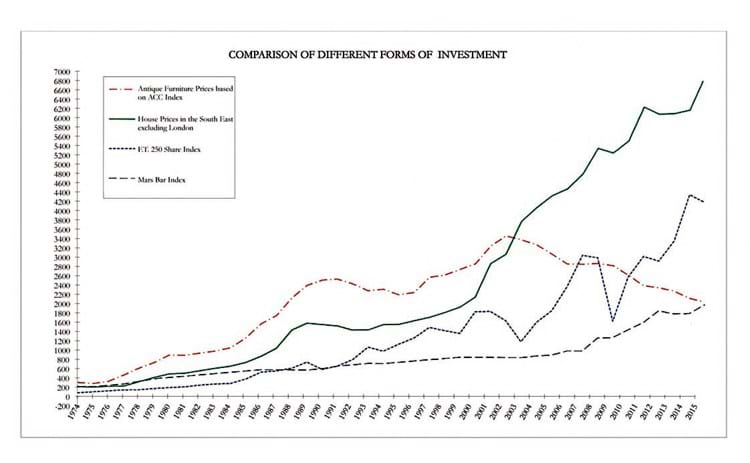
For reasons of fashion and function, the English antique furniture market remains in a parlous state, but this year's index suggests a relatively stable market dragged down by falling demand for oak and country furniture.
As a whole the index, based on a blend of retail and auction prices for 1400 typical (rather than exceptional) items pictured in John Andrews' book British Antique Furniture, fell by 4% last year. Set at 100 when Mr Andrews began the project in 1968, the index reached a high of 3575 in 2002, but now stands at 2149, down 67% from its peak and a level it last stood at in the 1980s.
Near-persistent decline has dogged the AFI over the past decade, including record falls of 7% in 2009, 8% in 2010 and 6% in 2013 - in contrast to the gains on the stock exchange (indexed this year at 4340) or the housing market in the South East of England (7117).
According to the AFI, antique furniture - a market that rode high on the wave of its investment potential in the 1970s and '80s - is struggling to keep pace with inflation (recorded here as the Mars Bar Index) across 45 years.
Not forgetting the exceptional prices occasionally posted for the 'aces' in this category, Oak (-8%) and Country (-10%) again showed the vulnerability that has marked them among the biggest losers in recent years. The Country index that stood at an apparently impregnable 3875 in 2008 is now down 62% to 2411. Much of the blame was placed at the feet of the high-back dressers - a once iconic period form that few 21st century kitchens can accommodate. Mr Andrews said prices here fell by around 20% with many dressers unsold at auction.
Antique Furniture Index
Oak: -8%
Walnut: 0%
Early Mahogany: -1%
Late Mahogany: -0%
Regency: -2%
Early Victorian: -3%
Country: -10%
AFI Total: -4%
Victorian & Edwardian Index: -3%
The three categories most associated with the wider decline in formal dining - Early Mahogany (-1%) Late Mahogany (0%) and Regency (-2%) - showed signs of returning to form after some dramatic falls earlier in the decade. In particular, sets of chairs, bergère armchairs and circular dining tables performed a little better in 2014, but gains registered were offset by losses to library tables and sideboards.
The flamboyance of much Regency furniture makes it vulnerable to fashion changes in interior décor, while anything too bulky for the modern interior meets negligible demand. For this reason post-1770 mahogany furniture now carries the lowest of all AFI index figures at 1624.
The means of compiling these figures have changed over the AFI's five decades. The internet has greatly facilitated the collation of statistics from a much wider range of sources than was available 40 years ago. "There is a widening disparity between retail prices and those at auction, which is leading to anomalies," said Mr Andrews, with London auctions in particular "tending to confirm the feeling that the capital is another country, with a separate economy".
Like dealers and auctioneers across the country, he continues to push the message that antique furniture is both better quality and value than modern alternatives - and points out the cyclical nature of fashion-led markets.
"Collectors should just enjoy acquisition while prices are so low. There is a feeling that we may be bumping along at the bottom of the cycle and it would be a shame to miss the opportunity while it exists," he said.
Victorian & Edwardian
The separate Victorian & Edwardian Index, launched in 1973 and once the recipient of spectacular gains (it stood at 2031 in 2003), has lost two-thirds of its value during the tailspin of the past decade. Falling a relatively modest 3% in 2014 (arresting the double-digit drops of previous years), it nonetheless stands at just 679.
While some forms remain strong, such as the upholstered tub chairs popular with interior decorators, other standard late 19th and early 20th century pieces, such as the davenport, the work table and the credenza, still languish among the unfashionable.
A full analysis of the AFI numbers is published in the February edition of Antique Collectors' Club magazine Antique Collecting.





